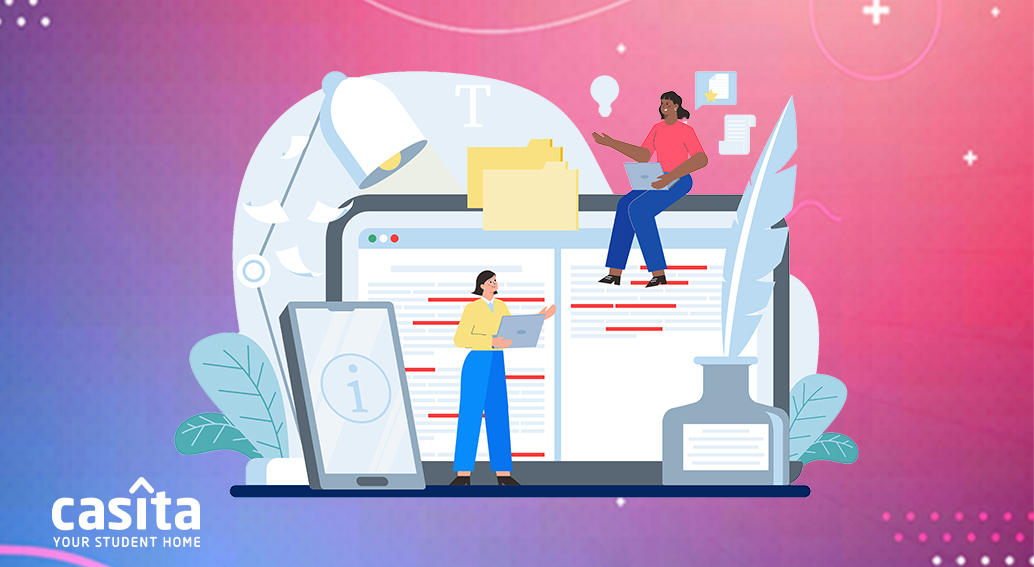Copyediting Tips for Students
Tips and Advice
5 mins read
Share

Updated at: 25 November, 2025
Published at: 13 July, 2022
By Amira Adel
Copyediting Tips for Students
Tips and Advice
5 mins read

Updated at: 25 November, 2025
Published at: 13 July, 2022
By Amira Adel
Share
The clarity of written text is improved by copyediting. Copy editors ensure that the writing is coherent and the transitions between sentences are seamless. They also offer comments on how to effectively convey the writer's point and review the work for consistency, punctuation, and spelling. Editing begins while you're still working on your first draft. Editing is more than just grammatical and obvious mistakes, the paper's organisation needs to be revised as well.
Concision, completeness, consistency, accuracy, and, last but not least, clarity are the five C's of copyediting. Here are some copyediting tips for students that will definitely help you.
1. Create an Editing Group
Students tend to think they have to do everything alone. However, it’s actually better if you swap your assignments and papers with your friends and fellow students to get more eyeballs on the work. A new set of eyes can catch errors you simply couldn’t see.
2. It’s and Its
Most students will still miss the contraction issue with "it is" while editing. Now let's settle this once and for all. The possessive pronoun "its" denotes ownership between the object of the pronoun "it" and another object. This is distinct from the contraction "it's," which merely denotes "it is."
One may type "John likes its red paint," for instance. Writing "John likes it's red paint," which, when the contraction is expanded, implies the same as "John likes it is red paint," would be wrong. There is no logic in expanding the contraction, of course. Some students are perplexed since in other sentences, like "John's automobile is red," possession calls for an apostrophe.
3. Their/there/they’re
This is one of the most important copyediting tips because even university students still mispronounce these words, as seen frequently in the papers they submit. This may sound like elementary spelling, something Grade 3 students would learn, but unfortunately, it still happens.
Check your papers and assignments for these words during the editing process to make sure you've used them correctly. They're is a contraction of they are, their is a possessive pronoun, and there is an adverb that modifies the verb go ("They went there").
4. Read Out Loud
This is one helpful copyediting tip for students. It's a good idea to read your work out loud before submitting it. When you reach this point, your objectivity has been compromised. You've read those lines several times over, so your eyes don't catch the mistakes because you know what you meant. Speaking out loud will help you discover awkward pauses and any missing words that your eyes have grown accustomed to overlooking.
5. Take a Break
This is the moment to get away from your laptop and engage in anything unrelated to computers for a few hours after reading your writing out loud and correcting any errors you may have discovered. It’s even better to leave it overnight.
By letting your eyes and brain rest, you can then reread your assignments with fresh eyes. You'll frequently be shocked by just how many errors your writing might contain!
6. Coherence
These days, a significant issue in student writing is paragraphs that are random collections of sentences. This issue may be related to copy-and-paste functions.
Each sentence in a paragraph should support the thesis or argument that is being made, which should be stated at the beginning of the paragraph. However, a lot of students have a tendency to randomly insert phrases into essays, leading to a tangle of unorganized ideas.
Think about the main idea of each paragraph as you are modifying it and ask yourself: "Do all of my sentences support that important point?" If not, they must be taken out.
7. PEEL It
PEEL stands for Point, Evidence or Example, Explanation, and Link.
Here’s what peeling means:
State your point and make it clear.
Back up your points with evidence and examples. To support your initial statement, you might want to utilise clear evidence or quotes from a reliable source.
By interpreting it for your reader, you can show how your data or example actually supports your argument. Instead of leaving people to guess what you mean or why you brought up these specific instances, think of it as doing the thinking for them. What happened after you asked the questions? Why does this matter? What resulted from it? Here, clarity and specificity are essential.
Relate the argument, supporting data, or examples to the essay's initial question. The phrases "this informs us that" and "this helps answer the question because" are good ones to keep in mind. This final stage essentially compels you to remain on topic in order to prevent turning in a bunch of fragmented sentences and odd thoughts and having your grades drop as a result.
8. Stop the All-Nighters
Writing documents in an all-nighter fashion does not result in error-free documents. It might be acceptable for producing a few thousand words, but you need at the very least a decent night's sleep and a clear head to spot grammar and style mistakes.
9. Check Your Sources
Avoid focusing just on the words when editing. Additionally, check your sources to make sure that you are accurately reporting or paraphrasing the thoughts of others.
This is among the most important tips for students. Sometimes students cite the wrong author, so, a quick check won’t hurt anybody; just go back to the original source and confirm it.
10. Watch Out For the Pinball
Do you notice a lot of quotation marks when you're reading your paper? You might have a pinball paper. A pinball paper contains just a little filler in between the large, fat phrases; the page bounces back and forth, just like a pinball (and that filler is your own words).
You are more than just the debate moderator when you write an academic paper. You are a leader defining your own stance by slicing through the thoughts and opinions of others.
11. Follow the Formatting Rules
For information on formatting requirements for your assignment, ask your teacher. Failing to follow the formatting guidelines (title pages, double or single spacing, citation styles, border size, and so on) screams a lack of attention to detail more than anything.
It's simple for teachers to take away points for these obvious mistakes. Similarly, see whether you addressed all of your teacher's questions or not, such as those about the argument or thesis, the scope, and the number of citations necessary.
12. Use a grammar/style plug-in
Install the Grammarly browser plug-in, and it will check your online work for 100 grammatical, spelling, and punctuation mistakes. The basic account is free. If you pay for an upgraded account, you can receive access to more types of checks, including plagiarism, in addition to the basic account's integration with Microsoft Word.
13. Use Paper
You don’t have to write your assignments on actual paper; it’s definitely a hassle, even though it would be better. However, it has been proven that when you print out your work and read it on paper, you might be able to catch more errors. Studies show that when we read text on screens, we overlook more mistakes (it has something to do with the backlighting and low resolution messing up our perception).
14. Keep It Simple
Cut the fluff, avoid using big words you don't fully grasp just because they seem sophisticated, and avoid using excessively long or run-on sentences.
Be ruthless and fall on the side of simplicity whenever you detect any of this while proofreading. Remember that if your professor or teacher doesn't immediately get what you're trying to say, they won't be able to give you full marks for clarity, which is almost surely going to be a factor in their essay assessment rubric.
There you have it! Just follow these copyediting tips for students while writing your assignments and research papers, and you’re all set! You can also check some other tips for students on How to Improve Your GPA and Tips for Studying in a Foreign Language.
Tips and Advice
By Amira Adel
Share
Tips and Advice
Updated at:
Published at:
By Amira Adel
Share



